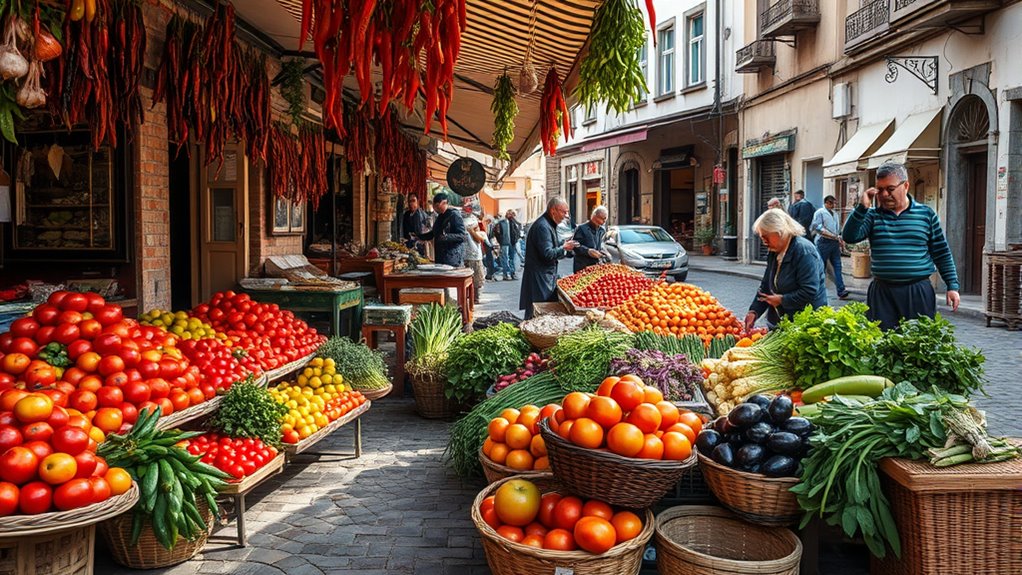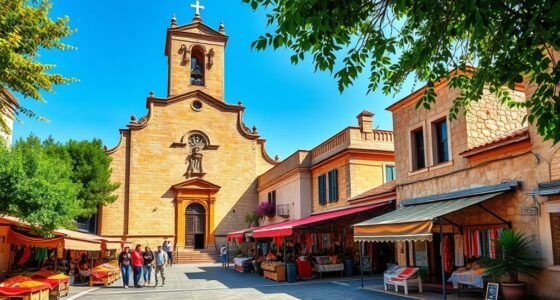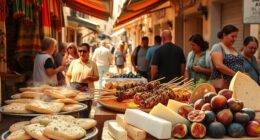At Ittiri’s Market, you’ll find seasonally fresh produce like citrus fruits in autumn, strawberries in summer, and hearty greens in winter. Look for regional cheeses like Pecorino and ricotta, along with traditional baked goods such as sourdough and carasau bread. Don’t miss local olives, olive oils, cured meats, and unique Sardinian delicacies. To make the most of your visit and enjoy peak freshness, explore market events and festival times detailed further below.
Key Takeaways
- Purchase citrus fruits like oranges and lemons in autumn, and strawberries in summer for peak freshness.
- Buy regional cheeses such as Pecorino Sardo and Fiore Sardo year-round, with seasonal variations in quality and flavor.
- Shop for seasonal vegetables like asparagus in spring, peppers and cucumbers in summer, and hearty greens in winter.
- Visit during local festivals (July, February, June) for the best selection of regional specialties and artisanal baked goods.
- Look for traditional Sardinian products like cured meats, olives, and extra virgin olive oil when in season or during specific harvest periods.
Exploring Seasonal Fruits at Ittiri Market
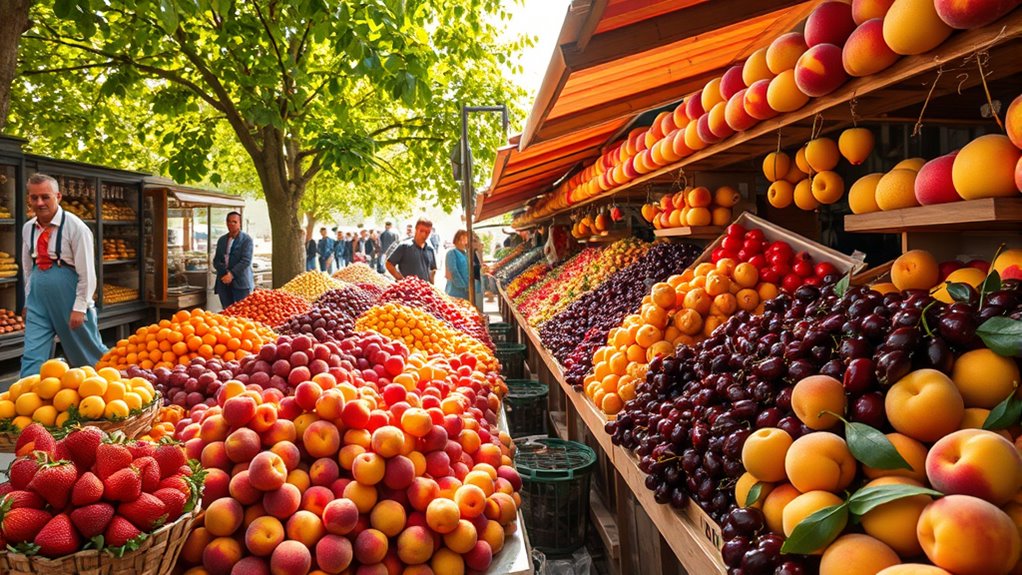
If you visit Ittiri Market throughout the year, you’ll notice how its fruit offerings change with the seasons. In autumn, citrus fruits like oranges, mandarins, and clementines start appearing, signaling the beginning of citrus season. Lemons and blood oranges are also available during early to mid-autumn, offering fresh, local options you won’t find year-round. Exotic fruits like prickly pear, or Barbary fig, appear from late summer through early autumn, with ripening stages visible starting in September. As spring approaches, citrus fades, replaced by wild and early-ripening fruits in April. When late spring and early summer arrive, strawberries burst onto the scene, adding a sweet highlight for desserts. This seasonal variety ensures fresh, local produce tailored to each time of year. Additionally, seasonal produce plays a vital role in supporting local agriculture and ensuring optimal freshness.
Fresh Vegetables to Look for During Different Seasons
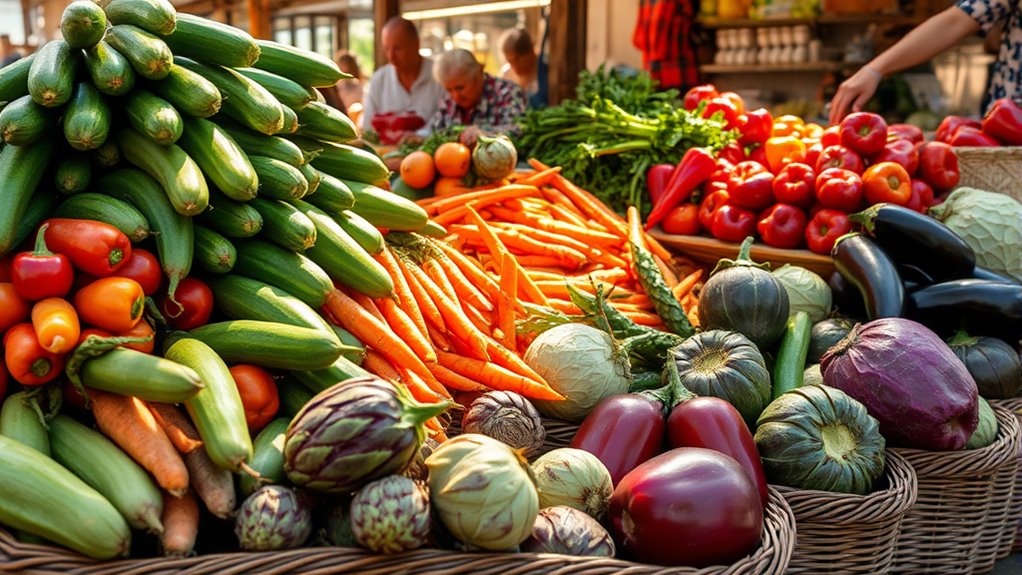
Throughout the year at Ittiri Market, the selection of fresh vegetables shifts with the seasons, offering you the best produce each period has to offer. In spring, look for asparagus in May, along with early spinach from March to May. Radishes and mushrooms also appear in early spring, adding crunch and umami to your dishes. As summer arrives, enjoy fresh broad beans, peas, cucumbers, tomatoes, courgettes, and bell peppers, all in peak season. In autumn, seek out kale, broccoli, cabbage, pumpkins, fennel, and artichokes, perfect for hearty meals. Winter brings colorful cauliflowers, hardy greens, onions, and root vegetables like carrots and potatoes. Keep an eye out for transitional vegetables like radicchio and herbs, which extend their availability across multiple seasons making them versatile ingredients for year-round cooking.
Traditional Sardinian Cheeses and Dairy Products

At Ittiri’s Market, you can explore a variety of traditional Sardinian cheeses, especially the local Pecorino varieties known for their distinct flavors. Don’t miss the fresh ricotta delights, perfect for spreading or adding to recipes. Tasting these cheeses gives you a true taste of Sardinia’s rich dairy heritage. Heritage and cultural significance of Sardinian cheese-making are evident in the artisanal techniques and centuries-old recipes passed down through generations. The natural materials used in traditional cheese production further enhance the authenticity and unique character of these dairy products.
Local Pecorino Varieties
Sardinia’s traditional pecorino cheeses offer a rich variety of flavors and textures that reflect the island’s long-standing sheep herding culture. When exploring local varieties, keep in mind these key types:
- Pecorino Romano: A hard, salty cheese aged 8–12 months, known for its sharp tang. It’s often grated over pasta or enjoyed as a table cheese, especially with broad beans in spring. Pecorino Romano is also protected by PDO status, ensuring authenticity and traditional production methods.
- Pecorino Sardo: A versatile, less salty cheese that matures to develop a richer, sharper flavor. It pairs well with fruits like pears and figs or used in pesto.
- Aging and Texture: Younger cheeses are soft and ivory-colored, while aged varieties turn firmer and more piquant, showcasing Sardinia’s dairy craftsmanship.
Fresh Ricotta Delights
Fresh ricotta is a cornerstone of Sardinian dairy delights, prized for its delicate texture and versatile flavor. Made from whey of sheep, cow, goat, or buffalo milk, it’s cooked at high temperatures to coagulate residual proteins. The result is a white, flaky, creamy cheese perfect for both savory and sweet dishes. Some versions are smoked with local herbs or oak wood, adding regional character. Fresh ricotta is low in fat, with a soft, slightly sweet taste, making it ideal for spreading on Carasau bread, drizzling with honey, or blending into desserts. Its mild flavor pairs beautifully with regional olive oil, herbs, and pine nuts. Consumed quickly, it’s best enjoyed within a few days, though proper packaging can extend its freshness for market sales. Incorporating herbal teas into your routine can also promote overall well-being, which complements the enjoyment of fresh, wholesome foods.
Traditional Cheese Tasting
Beginning a traditional cheese tasting in Sardinia reveals a rich tapestry of flavors and textures rooted in centuries-old methods. You’ll encounter cheeses like:
- Pecorino Sardo – semi-hard, sharp, and salty; perfect for grating over pasta or risotto. Pecorino Sardo is made from sheep’s milk and has PDO certification, ensuring its authentic Sardinian origin. Its production involves traditional cheese aging techniques that enhance its distinctive flavor profile.
- Fiore Sardo – smoky, spicy, and sharp; aged for months and enjoyed sliced or grated.
- Casu Axedu – soft and fresh; brined for 24 hours, then eaten plain or added to soups.
These cheeses are crafted from unpasteurized milk, aged in caves or cellars, and involve traditional techniques like brining and curing. Their flavors deepen with time, reflecting Sardinia’s cultural heritage. Pair them with local wines for an authentic tasting experience that captures the island’s dairy traditions.
Baked Goods and Artisanal Breads to Savor
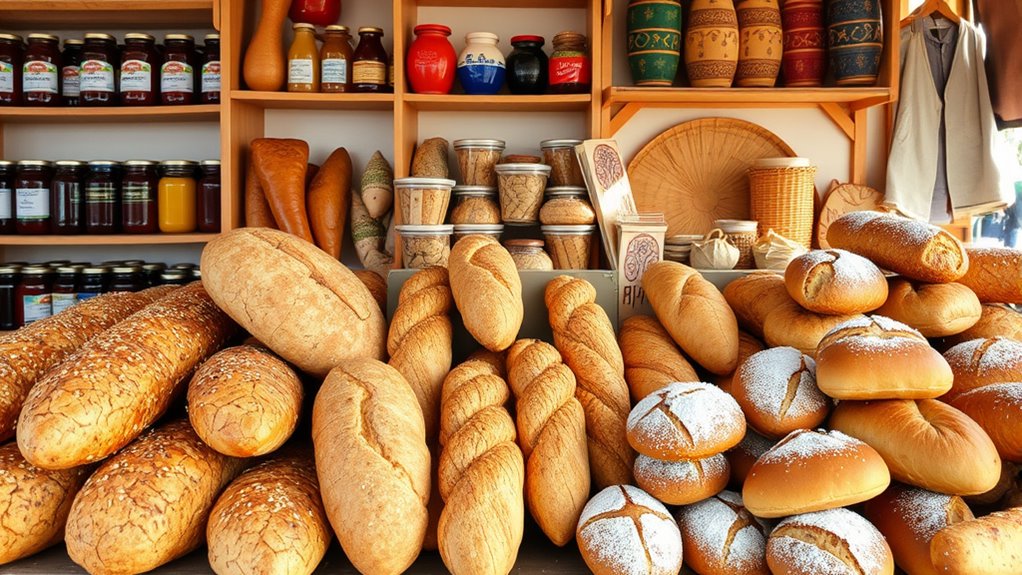
At Ittiri’s market, you’ll find baked goods that highlight regional grain varieties like spelt and einkorn, giving each loaf a unique flavor. Traditional baking techniques, such as long fermentation and slow baking, bring out rich tastes and perfect textures. Exploring local recipes like sourdough, focaccia, and rye bread reveals the craftsmanship behind these artisanal favorites. The process emphasizes patience and natural development of flavor, ensuring each bread is of the highest quality.
Regional Grain Varieties
In Ittiri and surrounding Sardinian areas, local wheat varieties form the backbone of traditional baked goods and artisanal breads, each contributing unique flavors and textures. You’ll find that:
- Karalis, a natural hybrid, offers a robust flavor perfect for artisanal breads.
- Senatore Cappelli, a hardy durum wheat, ensures healthy yields and resilience against environmental challenges.
- A blend of Pietrafitta, Saragolla, and Karalis supports crop resilience and forms the foundation of local flours. Preservation of traditional crops is essential for maintaining regional culinary heritage.
- These grains are cultivated with an emphasis on organic practices and traditional methods, preserving their unique qualities. These grains are used to produce iconic products like Carasau and Pistoccu, made from durum wheat, or Pane Nostu, which uses mixed flours for distinct aroma and texture. The regional grains define Sardinian baking’s authenticity and quality.
Traditional Baking Techniques
Traditional baking techniques rely on simple, high-quality ingredients like flour, water, salt, and natural starters to create flavorful, artisanal breads. These pure ingredients highlight the bread’s natural taste without chemical additives. Natural sourdough starters often replace commercial yeast, adding complexity and depth to the flavor. Using organic or specialty grains enhances nutrition and flavor profiles. Precise water temperature control, around 98° to 100°F, guarantees optimal yeast activation. Kneading is a rhythmic, manual process that develops gluten, shaping the dough’s texture. During fermentation, slow, extended periods allow flavors to deepen and gluten to break down, improving digestibility. Hand shaping and careful proofing create a rustic appearance and airy crumb. Baking in hearth-style or Dutch ovens at high heat produces thick crusts and tender interiors characteristic of artisanal breads. Understanding fermentation is essential for mastering the development of flavor and texture in traditional bread-making.
Popular Local Recipes
Discover the rich variety of baked goods and artisanal breads that define Ittiri’s culinary scene, showcasing local ingredients and timeless techniques. You’ll find delicious treats like:
- Ancini (Anise Cookies): Crunchy, aromatic biscotti flavored with anise seeds, perfect for holidays or coffee breaks. Traditional Sardinian baking methods emphasize careful preparation and baking to achieve the ideal texture.
- Seadas: Fried pastries filled with melted Pecorino cheese, drizzled with local honey, often enjoyed during festivals and celebrations.
- Pecorino Cheese Baked Pastries: Savory or sweet doughs infused with Pecorino and herbs, highlighting Sardinia’s dairy heritage.
These recipes emphasize Sardinian staples such as wildflower honey, saffron, and local wheat flour. Whether for daily enjoyment or festive occasions, Ittiri’s baked goods reflect the region’s rich culinary traditions. The mixture is quite stiff, which is normal for the dough. Properly baked biscotti are twice-cooked, resulting in their characteristic dry and crunchy texture that pairs beautifully with Sardinian Malvasia or Moscato wine.
Specialty Olives and Olive Oil Selections
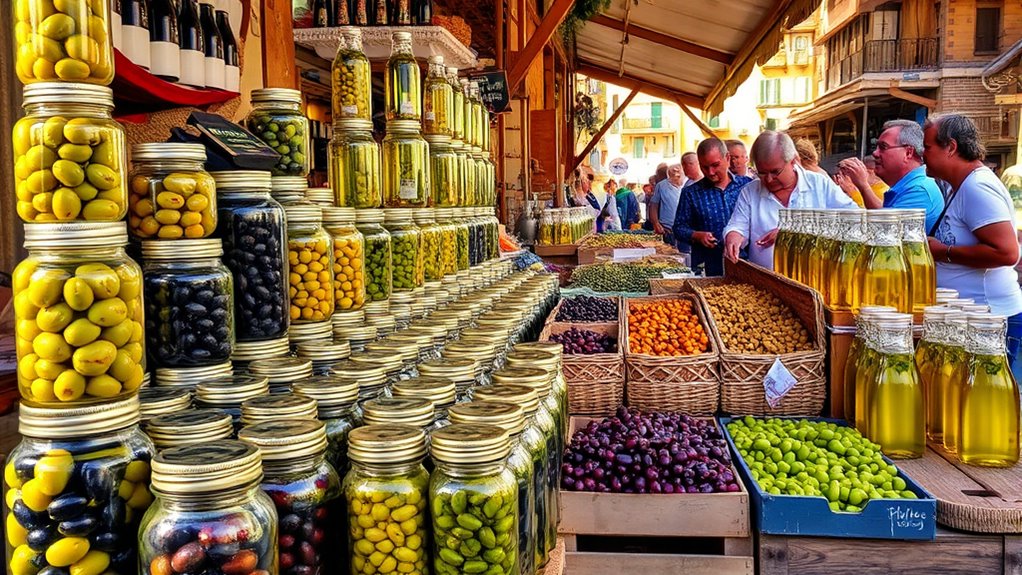
Are you ready to explore a world of bold flavors and artisanal craftsmanship? At Ittiri’s Market, specialty olives and olive oils showcase the region’s rich tradition. You’ll find Kalamata olives—large, deep purple, with fruity notes and hints of wine and vinegar—perfect for snacking or salads. Stuffed olives filled with blue cheese, almonds, or pimentos add gourmet flair, while spicy and smoked varieties offer complex, smoky, or chili-infused flavors. The green and black olives vary in texture and taste, depending on harvest and curing methods. Olive cultivation regions and their unique traits Complement these with local olive oils from central Italy, like Frantoio or Moraiolo, which range from grassy and nutty to bold and herbaceous. Early-harvest oils are green and peppery, while later harvests develop richer, fruitier flavors—ideal for finishing hearty dishes.
Unique Local Delicacies and Cured Meats
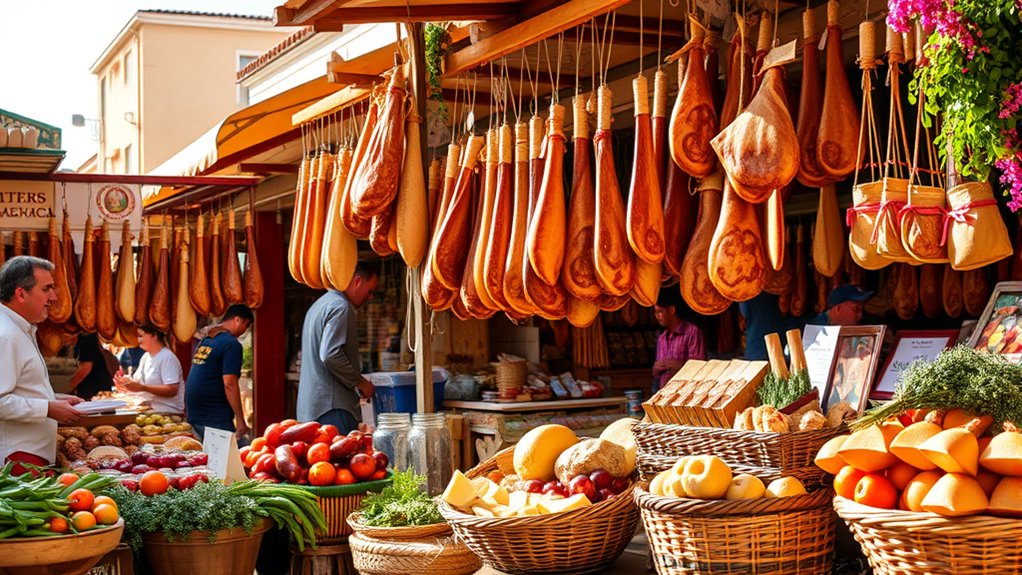
At Ittiri’s market, you’ll find a variety of unique local delicacies and cured meats that showcase the region’s rich culinary heritage. Here’s what to look for:
Discover Ittiri’s market treasures: cured meats and local delicacies that celebrate Sardinian culinary traditions.
- Famulari – Traditional Sardinian cured pork shoulder or ribs, salted and air-dried, offering a savory taste of local tradition.
- Salsiccia – Sardinian-style sausages seasoned with fennel seeds and local spices, available cured or fresh.
- Lonza – Air-cured pork loin flavored with herbs, known for its delicate, aromatic profile.
- Sardinian cured meats often incorporate unique regional spices and traditional methods that elevate their flavors.
Don’t miss the opportunity to sample Fresa cheese, a sheep’s milk delicacy, or grab some Bottarga, the cured mullet roe, especially during autumn. These authentic treats highlight Ittiri’s culinary craftsmanship.
When to Attend Market Events and Festivals

Timing your visits to Ittiri’s market guarantees you experience its vibrant traditions and unique offerings at their best. The best time to immerse yourself in local festivities is during the Ittiri Folk Festa in mid to late July, especially from July 17 to 22, when the town bursts into lively music, crafts, and food stalls. February’s Carnival offers colorful Sardinian costumes and street vendors, perfect for cultural exploration. June celebrates the patron saint, with markets full of religious artifacts and seasonal produce. Additionally, Sardinia-wide food festivals, such as the fish festival in July, enhance the market scene. Attending during these key festivals ensures you enjoy authentic local products, lively atmosphere, and a genuine sense of Sardinian heritage. Salude & Trigu Program also features over 100 events across Sassari and Olbia-Tempio in 2025, highlighting regional culture and traditions. Incorporating local economic insights can further enrich your understanding of the area’s vibrant market culture.
Tips for Making the Most of Your Market Visit
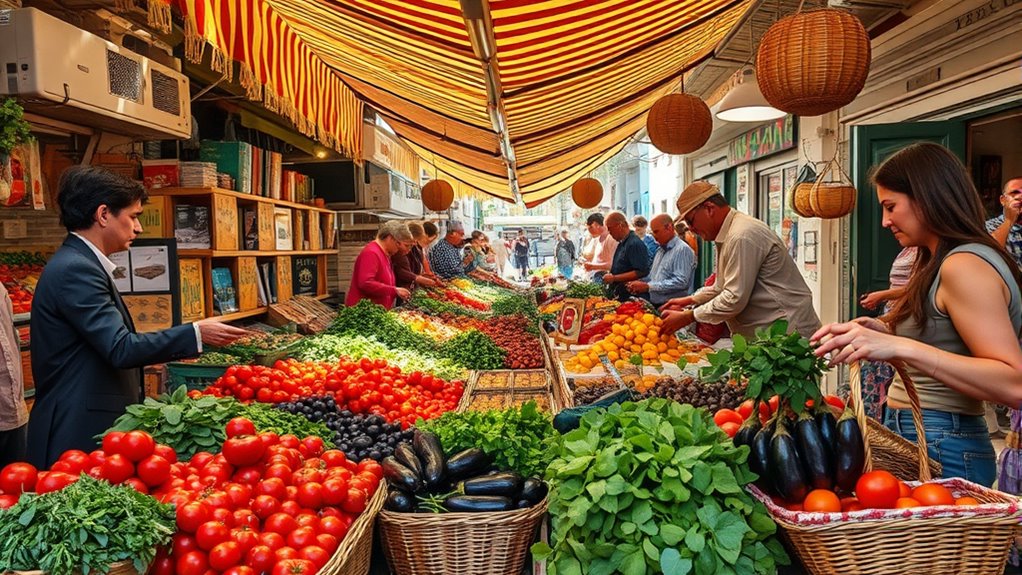
To make the most of your market visit, preparation is key. First, pack smartly: bring sturdy reusable bags, a small cooler for perishables, and keep your car trunk clean to avoid contamination. Second, engage with vendors—ask about produce origins, seasonal specialties, and sustainable practices to deepen your understanding and get fresh recommendations. Third, shop seasonally and flexibly by focusing on peak items, considering local produce, and using harvest guides to plan meals. Additionally, time your visit wisely: arrive early for the best selection or later for a relaxed experience, avoiding peak hours. Seasonal shopping supports local farmers and ensures freshness, so prioritize produce that is in peak season for the best quality and value. Being aware of market timing can help you avoid missing out on popular items and get the best deals. By staying organized, engaging vendors, and choosing ideal times, you’ll maximize quality, save money, and enjoy a more rewarding market trip.
Frequently Asked Questions
What Are the Best Times of Year to Visit Ittiri Market?
You wonder when’s the best time to visit Ittiri Market. Spring (March to May) is ideal, with mild weather, fewer crowds, and vibrant festivals. Early autumn (September) offers warm temperatures and fewer tourists. Summer can be busy, especially July and August, with crowds and higher prices. Visiting during these shoulder seasons gives you a more authentic experience, better deals, and pleasant weather to enjoy local produce and crafts.
How Can I Identify Authentic Sardinian Pecorino Cheese?
Sure, because everyone loves a good cheese mystery. To spot authentic Sardinian Pecorino, look for the PDO seal—no fakes here. Check the rind’s color—golden to dark brown with basket marks—and verify it’s firm, dense, and has that signature lamby aroma. Confirm it’s made from 100% raw sheep’s milk from Sardinia, aged over two months. If it checks these boxes, you’ve found the real deal!
Are There Any Local Crafting or Textile Products Sold at the Market?
You’ll find local crafting and textile products at the market that truly reflect Sardinian traditions. Look for hand-woven wool textiles dyed with natural colors from local plants and flowers, often featuring traditional embroidery. You can also buy cork products like purses and necklaces, delicate filigree jewelry, ceramics with classic blue-on-white motifs, and woven baskets made from natural fibers. These authentic crafts let you take a piece of Sardinia’s rich artisanal heritage home.
What Are Some Unique Seasonal Festivals Held at Ittiri Market?
Imagine stepping into Ittiri’s lively tapestry of tradition, where seasonal festivals paint the town with vibrant colors. You’ll find the Ittiri Folk Festival in summer, bursting with music, dance, and traditional attire. During other seasons, local celebrations like religious parades and craft fairs bring community spirit alive, inviting you to experience Sardinia’s rich cultural heartbeat. These festivals turn the market into a lively stage of heritage and joy.
Can I Find Organic or Sustainably Farmed Products Regularly?
You can find organic and sustainably farmed products regularly at markets, especially in larger or specialized stores. Look for USDA Organic labels or “Made with Organic” claims, which guarantee quality and sustainability. Organic produce, dairy, meat, and seafood are often available year-round, though availability varies by location. Shopping at markets that prioritize local, organic farms helps you access fresh, environmentally friendly options consistently.
Conclusion
To make the most of your visit to Ittiri Market, stay flexible and embrace the changing seasons. With a little patience, you’ll discover fresh finds and hidden gems that make every trip worthwhile. Remember, timing is everything—so plan your visit around market events and peak seasons. By doing so, you’ll get the best of what the market has to offer and come away with more than just groceries, but a true taste of local life.
